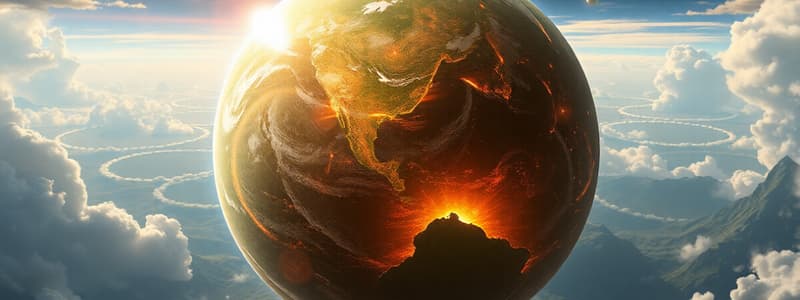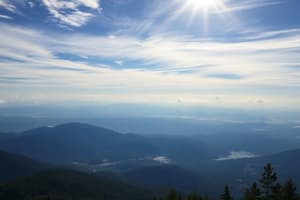Podcast
Questions and Answers
Which of the following is NOT considered a sphere of the Earth?
Which of the following is NOT considered a sphere of the Earth?
- Geosphere
- Hydrosphere
- Biosphere
- Stratosphere (correct)
What percentage of Earth's atmosphere is composed of oxygen?
What percentage of Earth's atmosphere is composed of oxygen?
- 21% (correct)
- 0.1%
- 50%
- 78%
Which sphere is characterized by containing all living organisms on Earth?
Which sphere is characterized by containing all living organisms on Earth?
- Atmosphere
- Geosphere
- Hydrosphere
- Biosphere (correct)
What is the outermost layer of Earth composed of physical matter?
What is the outermost layer of Earth composed of physical matter?
Which Greek prefix corresponds to the term for the sphere that includes all solid land?
Which Greek prefix corresponds to the term for the sphere that includes all solid land?
What is the approximate distance from Earth to the top of the atmosphere?
What is the approximate distance from Earth to the top of the atmosphere?
Which layer of the atmosphere is responsible for blocking ultraviolet radiation?
Which layer of the atmosphere is responsible for blocking ultraviolet radiation?
Which of the following spheres is considered abiotic?
Which of the following spheres is considered abiotic?
What is the primary characteristic that makes the biosphere unique?
What is the primary characteristic that makes the biosphere unique?
Which layer of the geosphere is the hottest?
Which layer of the geosphere is the hottest?
What is the primary form of water found in the hydrosphere?
What is the primary form of water found in the hydrosphere?
How deep can the biosphere extend below Earth's surface?
How deep can the biosphere extend below Earth's surface?
Which of the following layers is present in the geosphere?
Which of the following layers is present in the geosphere?
What is the process called when water from the hydrosphere falls to Earth's surface?
What is the process called when water from the hydrosphere falls to Earth's surface?
How do humans affect the interconnection of the spheres?
How do humans affect the interconnection of the spheres?
Flashcards
What is the Earth's crust?
What is the Earth's crust?
The thin layer of solid rock that makes up the Earth's outer surface. It includes landforms like mountains and valleys.
What is the Earth's mantle?
What is the Earth's mantle?
The layer of molten rock beneath the Earth's crust. It's incredibly hot and constantly moving.
What is the Earth's outer core?
What is the Earth's outer core?
The layer of liquid iron and nickel at the Earth's center. It generates the Earth's magnetic field.
What is the Earth's inner core?
What is the Earth's inner core?
Signup and view all the flashcards
What is the biosphere?
What is the biosphere?
Signup and view all the flashcards
What is the hydrosphere?
What is the hydrosphere?
Signup and view all the flashcards
What is the geosphere?
What is the geosphere?
Signup and view all the flashcards
What is the Atmosphere?
What is the Atmosphere?
Signup and view all the flashcards
Atmosphere
Atmosphere
Signup and view all the flashcards
Biosphere
Biosphere
Signup and view all the flashcards
Geosphere
Geosphere
Signup and view all the flashcards
Hydrosphere
Hydrosphere
Signup and view all the flashcards
Troposphere
Troposphere
Signup and view all the flashcards
Ozone Layer
Ozone Layer
Signup and view all the flashcards
What are the Four Spheres of the Earth?
What are the Four Spheres of the Earth?
Signup and view all the flashcards
Study Notes
Earth's Spheres
- Earth's matter is categorized into four interconnected spheres: atmosphere, biosphere, geosphere, and hydrosphere.
Atmosphere
- Definition: All the air on Earth.
- Origin: Greek prefix "atmos-" meaning "vapor."
- Composition: Primarily nitrogen (78%), oxygen (21%), argon (0.9%), and other gases (0.1%).
- Layers (from Earth's surface outward):
- Troposphere
- Stratosphere (contains the ozone layer)
- Mesosphere
- Thermosphere
- Exosphere
- Importance: Protects life from UV radiation, supports breathing.
- Extent: Extends ~10,000 km above Earth's surface.
Biosphere
- Definition: All living things on Earth.
- Origin: Greek prefix "bio-" meaning "life."
- Characteristics: Includes plants, animals, and microorganisms.
- Importance: Dependent on the other three spheres (atmosphere, geosphere, hydrosphere) to survive.
- Extent: Roughly 500 meters below Earth's surface to 6 kilometers above sea level.
Geosphere
- Definition: All solid land on Earth's surface and crust.
- Origin: Greek prefix "geo-" meaning "earth."
- Characteristics: Includes rocks, minerals, and four layers below the surface.
- Layers:
- Inner core (hottest, ~6000°C)
- Outer core (liquid iron and nickel, ~5000°C)
- Mantle (rock, magnesium, iron, ~871-4000°C)
- Crust (landforms, ~871°C)
- Importance: Provides habitat and resources for life.
Hydrosphere
- Definition: All water on Earth.
- Origin: Greek prefix "hydro-" meaning "water."
- Characteristics: Exists in three states (liquid, solid, gas).
- Composition: Mostly oceans (over 97.5%). Includes lakes, rivers, glaciers.
- Importance: Crucial for life on Earth, shapes ecosystems, contributes to weather.
- Interactions: Interacts with all other spheres (e.g., rainfall connects hydrosphere and geosphere).
Interactions Between Spheres
- The spheres are interconnected.
- Examples: rainfall (hydrosphere to geosphere, influencing biosphere), or human activities affecting multiple spheres.
Studying That Suits You
Use AI to generate personalized quizzes and flashcards to suit your learning preferences.




